Announcing that there was a full house assembled for the final performance of Garsington’s Le Comte Ory, the Festival’s artistic director Douglas Boyd was greeted by a spontaneous burst of applause. Certainly, the expectant audience were eager to be entertained by Rossini’s rollicking romp through medieval legend and the cast were more than happy to ham up the high jinks.
First performed at the Paris Opera in August 1828, Le Comte Ory is a ribald send-up of the early 19th-century Romantics’ obsession with medieval chivalry and romance. Eugène Scribe and Charles Gaspard Delestre-Poirson had milked the legend of the libidinous Count, a real-life Don Juan – made popular in Rossini’s day by the publication of various local variants – in the one-act vaudeville that they adapted for Rossini, Le comte Ory: Anecdote du Xle siècle, which was presented at the Théâtre du Vaudeville in 1816 – though they softened the reprobate’s degeneracy, substituting the chaste wives of crusading Knights for the convent of nuns who were the Count’s original victims in the medieval ballad. Rossini, too, indulged in some recycling for the expanded two-act opera, adapting music from Il viaggio a Reims, Rossini’s pièce d’occasion for the coronation of Charles X which had had only a short run in 1825.
Essentially a delicious comedy of errors, Le Comte Ory has little dramatic thrust. The brother of the Countess Adèle de Formontiers is away in the Holy Land, leading his knights in their battle against the Saracens, and the Countess has invited the men’s wives into her castle to pine away the days until their husbands’ victorious return. These ‘virtuous’ Penelopes are sitting targets for the lecherous aristocrat who attempts to inveigle his way into the waiting women’s nest by posing first as a miracle-working hermit and then as a sanctified Sister with a bevy of itinerant ‘nuns’ in tow. The Casanova Count’s two schemes to despoil Adèle’s virtue fall flat: every ruse is rumbled and the Duke’s arrival sees Ory and his fellow libertines slipping away to woo another day. The charm lies in the confusion of identity, especially when Ory becomes of the dupe of the disguise and attempts to seduce his own page, Isolier.
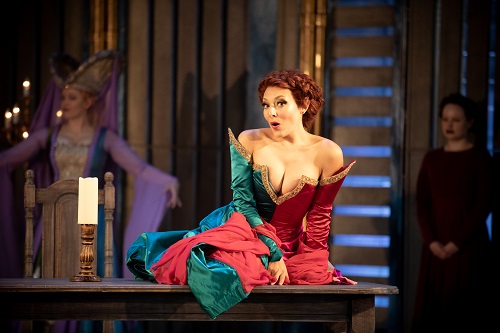
The opera is soufflé-light but the wit is polished, the innuendos avoid vulgarity, and Rossini’s score surprisingly delicate and stylish. One hears both the elegance of Mozart – especially in the aforementioned bedroom mix-up which recalls the nocturnal confusions of the final act of Figaro – and foreshadowings of Offenbach’s operettas. The orchestrations are wonderfully varied and imaginative, and conductor Valentina Peleggi drew every possible hue from the Philharmonia Orchestra whose superb playing contributed markedly to the richness of this last-night performance.
With the National Theatre’s One Man, Two Guvnors and ENO’s Iolanthe among his credits, there’s no doubting that director Cal McCrystal appreciates the value of laughter and how to create it. Being able to laugh at human vulnerability and mishap makes life and its trials, miseries and griefs more bearable, and it’s surely no coincidence that Boccaccio penned his Decameron in time of plague. McCrystal, however, eschews Boccaccio’s blend of the absurd and the wise, and plumps for the outrageousness of panto and the bawdiness of the seaside postcard à la Carry On. That Rossini’s elegant wit survives, just, is in no small part due to the marvellous medievalism of takis’ vibrant, fairy-tale designs and the invention of Tim Claydon’s choreography – and the precision of its execution by the ensemble cast.
Act 1 opens in a market square outside an Arthurian castle, its towers and trellises coated with lapis lazuli and gold; Act 2 turns the scene inside out and transports us to the castle’s interior, its darkened halls flickering with the dancing light of candelabras fantastically lit, during the second Act prelude, by the virtuosic taper-waving of a fairy-godmother straight out of Cinderella. Primary colours clash riotously, extravagant head-dresses soar. There are lots of Looney Tunes intrusions: a rabid rabbit that races back on forth electric wheels, as revved up as Ory himself; the grey-haired witch from Snow White who gleefully rubs her ruby-red apple, as if it is a crystal ball which will confirm an imminent assignation with the handsome young page. Are such ludicrous excesses gratuitous? Probably. Do they add to the hilarity? Definitely.
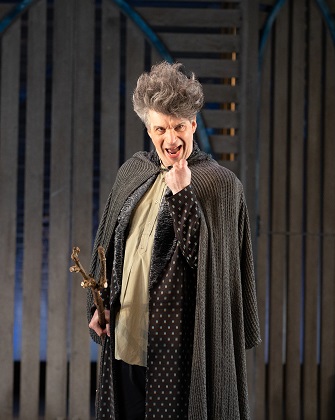
The ‘business’ of both solo numbers and ensembles is meticulously conceived and brilliantly implemented. The success of McCrystal’s superfluity of imaginative detail relies on the soloists’ innate sense of comic timing. As the Tutor given the slip by his ne’er-do-well charge, Joshua Bloom commands the stage – his patrician bass is as mellow as melted chocolate – even as the raging professor fluffs his catches, stumbles over his staff and trips on his star-embossed black gown.

It also requires painstaking rehearsal of the large ensemble numbers: the rib-tickling spontaneity of this sort of preposterous physical theatre is impossible to achieve without paradoxically serious preparation, and it’s just as impossible to imagine a socially distanced version of McCrystal’s outlandish frolic. Disguised as a hermit with the power to heal by hypnosis, Ory arrives – his travelling sales-wagon pulled by his partner-in-crime Raimbaud-cum-Rambo – with the self-assured panache of Dulcamara, sending the market-sellers and their clientele into a spin. Rossini’s forms are complex and extended, and the endless directorial invention that keeps the mendaciousness and mischief rolling along is impressive. The Garsington Chorus are absolutely terrific.
Only in the knights-in-drag knees-up in Act 2 does McCrystal push things a bit too far – the wine-fuelled acrobatics are a hoot, but the mooning and habit-hiking becomes a tad tedious. A little more subtlety wouldn’t have gone amiss here, of the kind that makes the nuns’ sly sliding beneath their tunics of the empty bottles which betray their boisterous debauchery , as they kneel to sweetly croon their evening prayer, such delicious fun. That said, the farcical joy of the flamboyant wimples which curl like wicked grins, and the inept inebriation of a single nun, who has to be dragged off by his feet, are impossible to resist.
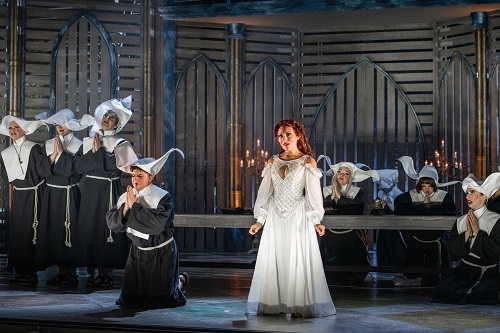
No more can McCrystal resist the exquisite brilliance of the Act 2 trio, ‘A la faveur de cette nuit’, which sees Ory divest himself of his religious robes and venture into Adèle’s bedchamber, where, forewarned, she is ready and waiting with her ‘protector’, Isolier. The luckless Lothario finds himself duped by a dummy – hastily assembled from stuffed pillow cases and Isolier’s trousers – tied to the bed-posts and subject to some bedtime bondage by tickly-hands-on-sticks, wielded with glee by his merciless muggers. Perhaps the sado-masochistic mayhem suppresses the confidential intimacy of the scene and the beautiful nocturnal shadings of the instrumental palette but it went down well at Garsington.
The title role was taken in the final two performances by Robert Murray (replacing Jack Swanson), and the tenor threw himself into the lunacy with gusto – especially when launching himself off the banquet table into the crossed arms of his fellow reprobates. Thankfully, the booze hadn’t blurred their eyesight! The vocal heights were occasionally an effort but Murray has the heft to subsume them within the drama, and used his strong technique, stamina and good musical judgement to bring them off persuasively. His French is engaging too, and he didn’t neglect the score’s more sensitive moments, revealing a lovely leggero tenderness at appropriate moments.
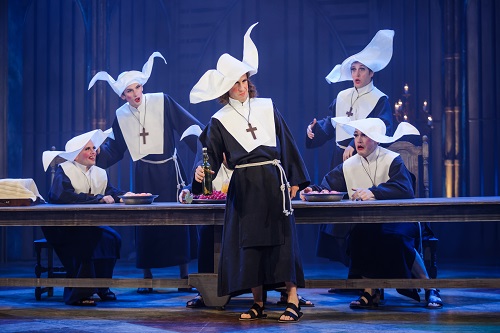
As his sidekick, Raimbaud, Jacques Imbrailo was luxury casting, and the baritone demonstrated the grace of voice and physicality that was such a winning aspect of his Billy Budd. Arriving in the gallery above the banqueting hall, he delivered a captivating account of his ‘crusade’ in the wine cellar, tottering convincingly on the banister, before descending to regale his friends further in a boozy table-top turn of paradoxical vocal classiness.
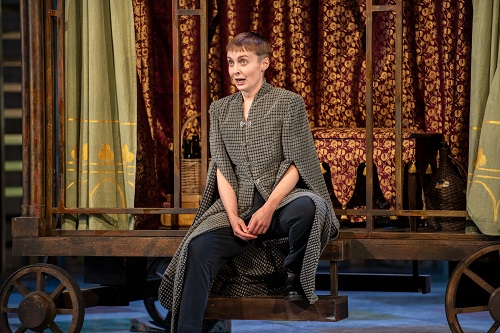
Patricia Bardon was a no-nonsense Dame Ragonde, swiftly snapping – with a toe-curling crunch – the neck of a chicken upon her arrival in the marketplace, a ruthlessness subsequently belied by Bardon’s warm expressive mezzo. Katie Bray’s Isolier displayed the adolescent ardour of a Cherubino, Bray’s beautifully fluent line and sweet, clear tone winning our affection for the lovelorn page.
Star of the show, though, was the American soprano Andrea Carroll who, as Countess Adèle whirled through the coloratura with the style and ease with which she did the splits. The evenness and extent of Carroll’s range is remarkable, gleaming at the top, creamy in the middle, and rich and dark at the bottom. Ory never stood a chance against this savvy Countess.
Le Comte Ory was Rossini’s farewell to comedy, just as this performance was Garsington’s farewell to a wonderful, ‘against-the-odds’, 2021 season. As Ory and his men observe, ‘What an excellent piece of folly! It’s charming, it’s divine!’
Claire Seymour
Count Ory – Robert Murray, Adèle – Andrea Carroll, Isolier – Katie Bray, Raimbaud – Jacques Imbrailo, Ragonde – Patricia Bardon, Tutor – Joshua Bloom, Alice – Milly Forrest, Courtiers (Liam Bonthrone, Leila Zanette, Matthew Palmer); Director – Cal McCrystal, Conductor – Valentina Peleggi, Designer – takis, Lighting Designer – Jake Wiltshire, Choreographer – Tim Claydon, Philharmonia Orchestra, Garsington Opera Chorus.
Garsington Festival Opera, Wormsley; Sunday 25th July 2021.
ABOVE: Le Comte Ory at Garsington (c) Alice Pennefather